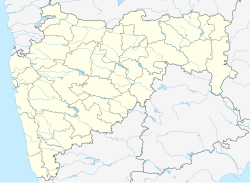Aurad Shahajani
Aurad Shahajani | |
|---|---|
Town | |
| Nickname: Aurad | |
| Coordinates: 18°05′45″N 076°53′17″E / 18.09583°N 76.88806°E | |
| Country | |
| State | Maharashtra |
| District | Latur |
| Taluka | Nilanga |
| Government | |
| • Body | Grampanchayat |
| Population (2001) | |
• Total | 20,154 |
| Demonym | Auradkar |
| Languages | |
| • Official | Marathi |
| Time zone | UTC+5:30 (IST) |
| ISO 3166 code | IN-MH |
| Vehicle registration | MH 24 |
| Lok Sabha constituency | Latur |
| Vidhan Sabha constituency | Nilanga[1] |
| Website | maharashtra |
Aurad Shahajani is a Town located in the Nilanga Taluka of Latur District It's 20 kilometres Away From the City Of Nilanga And 68 Kilometres Away From The City Of Bidar And It's Situated In Maharashtra And Karnataka Border. Its located at the banks of terna river. Its One of the Most Developed Places in Nilanga Taluka.
Languages
[edit]Marathi is widely spoken in the region. Hindi, Urdu, Kannada and Telgu are also common in the village.[citation needed]
Location
[edit]Aurad Shahajani is located on the banks of Terna River in central west India. It is closer (approximately 220 kilometres (140 mi)) to Hyderabad in the state of Telangana than it is to the capital of Maharashtra state, Mumbai.
Geography and climate
[edit]| Aurad Shahajani | ||||||||||||||||||||||||||||||||||||||||||||||||||||||||||||
|---|---|---|---|---|---|---|---|---|---|---|---|---|---|---|---|---|---|---|---|---|---|---|---|---|---|---|---|---|---|---|---|---|---|---|---|---|---|---|---|---|---|---|---|---|---|---|---|---|---|---|---|---|---|---|---|---|---|---|---|---|
| Climate chart (explanation) | ||||||||||||||||||||||||||||||||||||||||||||||||||||||||||||
| ||||||||||||||||||||||||||||||||||||||||||||||||||||||||||||
| ||||||||||||||||||||||||||||||||||||||||||||||||||||||||||||
Aurad Shahajani is situated 636 metres above mean sea level, on the Balaghat plateau, near the Maharashtra–Karnataka state boundary. It receives its drinking water from the nearby Terna River,Terna joins to Manjra river here at this village and then named Wanjara by the name of Wanjarkheda (a village at the other bank of river in Karnatka state) which suffered from environmental degradation and silting in the late 20th and early 21st centuries. Master Deenanath Mangeshkar Mahavidyalaya and some other villagers tried successfully to wide shape of river.
Temperature : Annual temperatures in range from 13 to 41 °C (55 to 106 °F), with the most comfortable time to visit in the winter, Aurad Shahajani is October to February. The highest temperature ever recorded was 45.6 °C (114.1 °F). The lowest recorded temperature was4.5. 2.2 °C (36.0 °F). In the cold season the district is sometimes affected by cold waves in association with the eastward passage of western disturbances across north India, when the minimum temperature may drop down to about 2 to 4 °C (36 to 39 °F).[2]
Rainfall : Most of the rainfall occurs in the monsoon season from June to September. Rainfall varies from 9.0 to 693 mm/month. Average annual rainfall is 725 mm.
Culture
[edit]There is a temple dedicated to the Hindu goddess Bhavani that is associated with Chhatrapati Shivaji Maharaj jayanti.
Media and Communication
[edit]Newspapers
In Aurad Shahajani, the most widely read Marathi newspapers are:
- •Lokmat
- •Loksatta
- •Sakal
- •Ekmat
- •Punyanagri
Additionally, some residents read English newspapers such as:
Other Marathi daily newspapers available include:
- •Lokman
- •Marathwada Neta
- •Rajdharma
- •Sanchar
- •Sarathi Samachar
- •Tarun Bharat
- •Yashwant
Demographics
[edit]In the 2001 Indian census, the suburb of Aurad shahajani recorded inhabitants, males (51.4%) and females (48.6%), for a gender ratio of 945 females per 1000 males.[3]
References
[edit]- ^ "Assembly Constituencies-Post delimitation: Maharashtra: Latur District" (PDF). National Informatics Centre, Government of India. Archived from the original (PDF) on 29 April 2013.
- ^ Maharashtra government web site Archived 13 February 2009 at the Wayback Machine
- ^ "Census 2001 Population Finder: Maharashtra: Latur:Nilanga:Aurad shahajani". Office of The Registrar General & Census Commissioner, Ministry of Home Affairs, Government of India. Archived from the original on 1 March 2018. Retrieved 1 July 2018.


